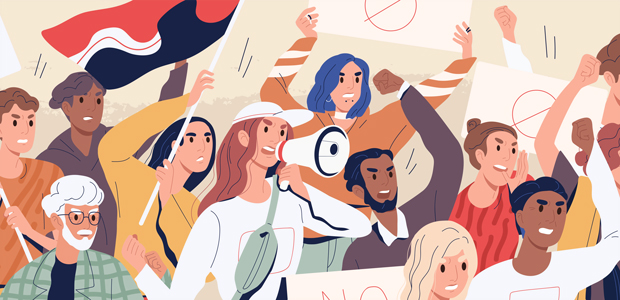
Every revolution needs an enemy – why brands need to identify that foe
Knowing your enemy is more important than ever. Whether as an individual, a consumer or a brand, defining your enemy creates momentum and can be the catalyst for positive change.
Even before the seismic shift of a global pandemic, at 0120 (formerly Evolve), we realised that this thinking was becoming paramount. But the novel coronavirus has pushed it into sharp focus. We believe that brands – and design more widely – can no longer rely on the tried, tested (and tired) tools of traditional demographics, or questions around ‘Generation X, Y, Whatever’. These schools of approach are outdated. The enemy can also change significantly, depending on different cohorts and psychographics.
We need to segment differently. By groups, people, beliefs or societal shifts. Our concept of the enemy can help with this. It is a more amorphous way of framing your principles, more suitable to today’s challenges. It allows you to question the norm and societal conventions and to identify how to set yourself apart.
Brands that dig deep to identify that enemy are the ones that effect lasting change. They will engage most successfully with their audience. Canadian skincare brand The Ordinary, for example, pitched itself against the enemy of over-priced and over-hyped beauty products. Since its launch in 2016, it has led the way with affordable beauty alternatives and arguably changed the beauty sector forever. Its principles and genuine purpose are baked into its every touchpoint. Unsurprisingly, sales are impressive – its 2019 revenue was predicted to be $330 million.
Forget about your obvious competitor – the enemy looms wider
When we apply this thinking in a branding context, it is all too easy to slap the enemy label on your closest competitor – “Who is my competition? How can I beat them? How can I do things better or differently?”. But you need to look more expansively to identify your most useful enemy. For example, what is the situational enemy, the political enemy – the entrenched system or behaviour that needs to be fought? Is your enemy as specific as a bland housing development, or as considerable as the UK’s planning laws?
The Hiut Denim Company illustrates this approach beautifully. The brand was born when small Welsh town Cardigan faced a very real enemy – unemployment. Its people had been making denim for 30 years. But from one moment to the next, that livelihood disappeared, leaving behind 400 people with knowhow and skill, but no way to apply it.
Hiut founder David Hieatt decided to build the brand to square up to that enemy. He wanted to support the town in doing what it does best – “to breathe new life into our town”. Such a powerful starting point resulted in san equally powerful brand, with a convincing message – it was about doing one thing incredibly well, making the perfect pair of jeans. The company enjoyed impressive results pre-lockdown, a massive fanbase and growth (40% in 2019). But most importantly, Cardigan had a new lease of life.
Monzo Bank, meanwhile, took the sword to the use of regulation as an excuse in the banking industry. No more bowing to theoretical regulation as a hurdle to providing a better product to banking customers. This insight turned the Monzo customer’s experience on its head, making it more useful, more user-friendly.
Sustain the fighting spirit
These examples show how identifying an enemy can be a powerful tool to differentiate and stand out. But don’t be tempted to identify an enemy and then rest on your laurels. The biggest pitfall when taking this approach is exponential change, finding an enemy one week and then thinking the job is done for a year.
Identifying your enemy gives you the platform and the buoyancy to find your true sense as an organisational brand. The next challenge is to keep that message and build everything around those principles. But you also need to articulate and adapt it to blend with constant developments in the world, otherwise that exponential change will slap you in the face.
We introduced this thinking at new restaurant Darby’s. It is a prime example of how such agility is crucial. Driven by the promise of “good honest grandeur” (and the enemy of soulless food and bland new restaurants), Darby’s opened last year with the ambition to become a true community eatery in London’s Vauxhall. We wanted to create a place that felt it had been around for years, with a spirit that stood in contrast to sweeping gentrification, which so often results in identikit, uninspiring neighbourhoods.
This focus, and Darby’s offering of superior, locally sourced food and friendly atmosphere, helped it grow a genuine and engaged community. In a sector in which it is so easy to fail, challenging its enemy has made it more future-proof.
Leave the lumbering giants behind
We believe this is an exciting time for challenger brands, for start-ups that are prepared to position themselves in this way. The COVID-19 pandemic has resulted in an unprecedented moment when many pre-existing truths have been either irreversibly disrupted or fundamentally challenged. It has seen those with an entrepreneurial spirit and guts challenge the status quo.
It is a mistake to see ‘a return to normality’ as the ultimate goal right now. Instead there’s an opportunity to do good work, in the true sense of the word. Meaningful work. Impactful work. If you want to have a part of it, start singling out your enemies, and pick a fight.

